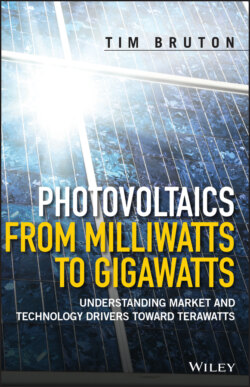Читать книгу Photovoltaics from Milliwatts to Gigawatts - Tim Bruton - Страница 16
1.2.4 The First Successful Market: Satellites
ОглавлениеAlthough a terrestrial market was slow to materialise, Hoffman Electronics continued to do research to improve solar cell efficiency and reduce cost. By the end of 1957, it had demonstrated a 12.5% (1 cm2)‐efficient silicon cell [33]. The discoveries at Bell Laboratories did not pass unnoticed amongst the military, and the US Army Signal Corps visited the company to evaluate the technology and concluded that the only viable application was for the power supply of an artificial earth satellite, which was a top secret project at the time [34]. This view was shared by the US Air Force – but not by the US Navy, which was eventually awarded the satellite project, and which had decided that silicon solar cells were ‘unconventional and not fully established’ [34]. Interdepartmental rivalries also played a part [35]. Nonetheless, when President Eisenhower first announced the satellite programme publicly in 1955, the New York Times published a sketch showing solar cells providing the power. Intense lobbying was carried out, particularly by Dr Hans Ziegler of the Signal Corps Research and Development Laboratory (USARDL), assisted by a decision to simplify the satellite’s mission and lighten its payload. Eventually, it was agreed that both a dry cell battery power supply and a solar‐powered transmitter would be used. Solar cells were tested by attaching them to the nose cones of two high‐altitude rockets and were shown to survive the rigours of the launch and of the space environment.
The first launch in December 1957 of the Vanguard TV‐3 satellite, depicted in Figure 1.6, failed, but the satellite itself was recovered [36]. The Vanguard 1, identical to the TV‐3, was successfully launched on 17 March 1958, with the expectation that it would remain in orbit for 2000 years (although later recalculation lowered this to 240 years). It is the oldest artificial satellite still orbiting the earth. Its scientific purpose as part of the International Geophysical Year was to obtain geodetic measurements of the shape of the planet. As predicted, the battery‐powered transmitter stopped working in June 1958, while the solar‐powered one continued until May 1964, when the last signals were received in Quito, Ecuador. The satellite was a 16.5 cm aluminium sphere weighing 1.48 kg. A 10 mW 108 MHz telemetry transmitter was powered by a set of mercury batteries, while a 5 mW 108.03 MHz beacon transmitter was powered by solar cells mounted in six 5 × 5 cm arrays, which gave a nominal power of 1 W, equating to an efficiency of 10% at 28 °C [34]. The cells were supplied by Hoffman Electronics.
Figure 1.6 Vanguard TV‐3 satellite on display at the Smithsonian Air and Space Museum. Recovered from its failed launch on 6 December 1957 [36]
Source: Smithsonian National Air and space Museum (TMS A19761857000cp02)
This proved to be a watershed moment for photovoltaics, as the technology had proved itself a reliable long‐term source of electricity in a real application.
